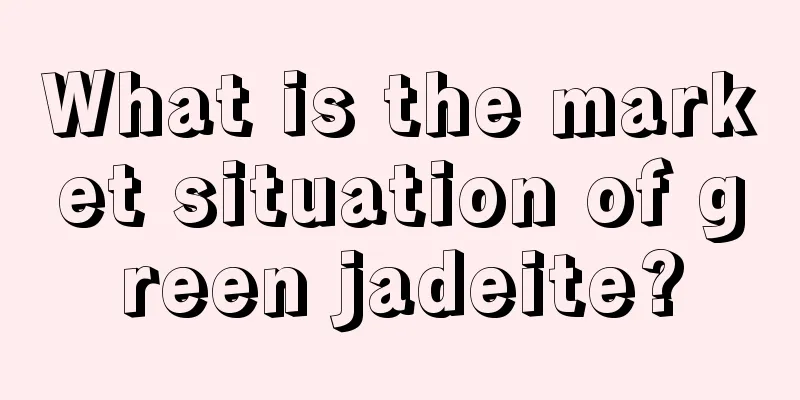Do you know how to distinguish the three greens of jadeite?

|
The "three greens" in jadeite refer to three types: flower green, dry green and oily green. For jade novices, it is still difficult to distinguish them. Today, the editor will talk to you about the differences between the "three greens" of jade. The following are useful information, so hurry up and collect and pay attention. In fact, it is not difficult to find that they all have the word "qing" in their common color, which means that their tones are mainly cyan. So how do we distinguish them by color? Now let’s listen to the experts and tell you in detail. First, let’s talk about the flower-green jadeite. Its base color is green or colorless, and the color varies in depth. Some are relatively dense, and some are relatively sparse. The green is mostly a cyan tone, unevenly distributed, and more "flowery". The biggest difference between it and dry green and oily green is the uneven green. The base is generally opaque to slightly transparent, the jadeite crystals are in the form of fine columns and fibrous (metamorphic) aggregates, and the sound of the jade when tapped is like that of stone. It can be roughly divided into bean flower green (the base is bean-type blue, and the green is irregular or floating), and horse tooth flower green (the base is horse tooth type). Most accessories are processed into pendants, bracelets, and carvings. Those with bright green and slightly transparent colors are mid-range, while the others are mid-to-low-range. Cyanine Cyanine Ganqing jadeite usually appears full green, but the green also varies in depth, and the surface luster is dull. It is often accompanied by black spots, black lines, and black blocks, and the crystal particles are large, the structure is rough, and the transparency is very low. Because of its green color, it is often used to make thinner inlaid jewelry. There are also dry green bracelets, but they are often made into carved bracelets. The content of sodium chrome pyroxene in dry green jadeite is very high, which means that a large part of the characteristics of dry green jadeite come from sodium chrome pyroxene. The dry green jadeite seen on the market is usually "dry", has no water head, low hardness, and more cracks, which is the main reason why this type of jadeite is called "dry green jadeite". In the traditional jadeite market, dry green jadeite has been questioned because its main constituent mineral is sodium chrome pyroxene, and this issue is still controversial today. But we have to affirm that the audience for dry green jadeite is indeed expanding, and more and more people like it. Dry green Dry green The color tone of Oily Green Jadeite tends to be dark in series, in line with the characteristics of "green with gray". The gray tone is darker and has a gray and evil feeling. This color does not seem to have much direct connection with green. The color tends to be more "gray" or "gray-black". Some Oily Green Jadeite has some blue mixed in the gray. Compared with the dry green variety, the oil green variety, except for the difference in color, has a relatively delicate base, without any black spots or dark spots, and the water head is much better. Oil Green Oil Green Oil green jade can be divided into three grades: high, medium and low. Among them, high-grade Oil green jade is quite rare. Its color is very uniform, its transparency is very good, and it has a certain luster. Although the color of this kind of Oil green jade belongs to the gray tone, the tone does not have a gray and dull feeling, but reveals masculinity and righteousness in the gray. The price of this kind of Oil green jade is very high, ranging from several thousand yuan to tens of thousands of yuan. fcgc66 f fcgc33 |
<<: What should you pay attention to when choosing a jade pendant?
Recommend
No one is perfect, and no jade is perfect. How to choose the jadeite you like?
First of all, everyone should know that jade is a...
Why are violets called "death in the light"?
Jade has a variety of colors. In addition to the ...
Are A-grade jadeite fake? What is the method to identify A-grade jadeite?
"People take care of jade for three years, a...
A brief discussion on jadeite collection: never take the price of jadeite as its value
In our cognition, we usually think that if someth...
Feel the natural beauty of jade and appreciate its unique charm
It is recorded in ancient books: "Appreciate...
Jade Appreciation | A Summer Resort for the Soul
Everyone in the city, Probably everyone can't...
Why does the Jade Guanyin have her eyes closed and doesn’t wear shoes?
Guanyin is a very common subject in jade carvings...
How important is the “base” of jade ornaments?
As the saying goes, "The most beautiful scen...
What is jade made of and how is it formed?
Jadeite, also known as jadeite jade, jadeite and ...
How to Identify A-Grade Jadeite
Jade is the most popular counterfeit object among...
Nothing to do is a good thing, let us take you to experience the highest realm of the jadeite Wu Shi Pai!
Jade is naturally beautiful, picturesque, and maj...
The value of an inconspicuous piece of jade scrap instantly increases tenfold after being skillfully carved by a sculptor!
This is a piece of jade scrap after being harvest...
Your jade is dull and lifeless, it may be due to several reasons!
Recently, many jade lovers have complained to the...
Jade Appreciation | Oily Green, the Beauty of Gray Tone
As the name suggests, Youqing is a kind of jade t...
How to collect and hide jadeite? If you don't, you will suffer a great loss.
What is your purpose for purchasing jadeite? Is i...









